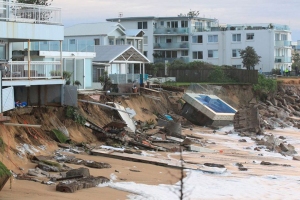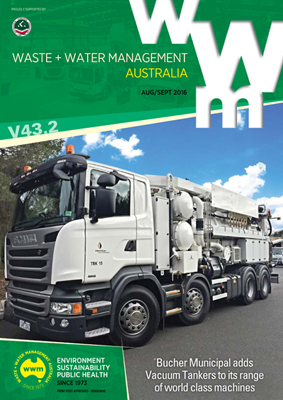The time for action on climate change is now
By Mike Ritchie – Managing Director, MRA Consulting Group

The iconic photographs of an in-ground swimming pool stranded on a Collaroy Beach last month are a stark reminder of what severe storms and king tides can and will do to our coastline with ongoing sea level rise.
The Insurance Council of Australia has said that Australia’s East Coast storms resulted in an estimated damage bill of $235 million.
But in the overall scheme of things, Collaroy is in fact trivial.
The Commonwealth Government’s National Coastal Vulnerability Assessment (NCVA, 2009) (of which I was a part author) warned that 157,000 – 247,000 individual residential buildings (multi-unit flats are counted as a single dwelling) are at risk with a sea level rise of 1.1 metres by 2100.
This assessment was based on a “bath tub” model (it assumes sea level rises evenly like water in a bath). It therefore ignores the additional effect of storm surges and king tides, which make damage considerably more likely and more prevalent.
The damage to housing alone was estimated at $63b (replacement value in 2008 dollars).
A 2011 follow up report into commercial buildings, industrial precincts and transport infrastructure found a further $226b in coastal assets at risk (also in 2008 dollars). A total of $289 billion in infrastructure losses alone.
This dwarfs the actual $28.6b damage bill from all major floods, tropical cyclones and severe storms that occurred between 1967 and 1999. This represented over 75% of the total cost of natural disasters in Australia during that period.
A sea level rise of 1.1 metres is a high end scenario. However, even a mid-range scenario of 0.5 metres sea level rise by 2100 sees a sharp increase in storm frequencies and damage.
The National Coastal Vulnerability Assessment also states that events that are currently expected to happen every 10 years will happen every 10 days in 2100. The current 1-in-100 year events (such as Collaroy or the 2007 storms in NSW which caused insurance losses of $1.3b) would happen regularly.
The question is why isn’t the media giving Australians a realistic picture of what the science is telling us. If anything, scientists are now finding that they have underestimated the impact of climate change (not overestimated it as vociferously argued by sceptics).
How many readers knew of the National Coastal Vulnerability Assessment and its follow up reports at both national, State and local government levels?
While I can understand the media’s breathless commentary about Collaroy (the pictures are made for TV), I cannot understand why they don’t paint a picture of what Australia will look like with a 2oC temperature rise, or with a quarter of a million houses threatened by inundation. Do we discount the future that much?
While Australia has always been at the mercy of storms, droughts and floods, the climate science tells us the future will be much more extreme. Many, if not most, low lying houses on the coastal plains and coastal foredunes are now knowingly at risk.
A recent paper in Nature concludes that the actions committed to in Paris do not match Paris agreement goals. Essentially, the Paris Agreement aim for under 2°C warming cannot be achieved through the plans pledged. The world, including Australia, needs to take much more serious action on abatement of greenhouse gas emissions and on mitigating the risks of sea level rise, storms and floods.
A price on carbon is still the most efficient way to achieve abatement. I have previously written that with two minor tweaks the Direct Action Safeguard Mechanism could be converted into a viable carbon pricing mechanism.
In respect to mitigating impacts we need to be honest with people. If you own a house or building in the coastal zone, the risk of inundation is rising with the rise in sea level. And it will be very difficult to insure against inundation or the effects of climate change. The Australian insurance industry has also made that clear (NCVA, 2009).
It is time for bipartisan approaches to all related factors: internationally push for global cooperation and action and locally pursue abatement of emissions, mitigation of impacts and importantly communicate the real risks to the Australian community.
As always, I welcome your feedback on this, or any other topic on ‘The Tipping Point’.
Image: ABC News
This article has been published by the following media outlets:
 Waste + Water Management Australia, September 2016 (click to view)
Waste + Water Management Australia, September 2016 (click to view)




